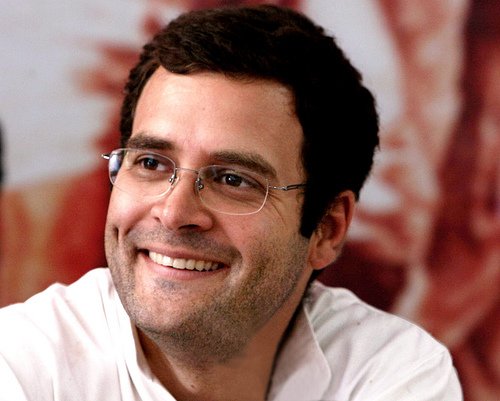Vivek Kaul
Rahul Gandhi, the vice president of the Congress party, is on an extended vacation. This at a point of time when the first half of the budget session was under progress.
The Narendra Modi government has been trying to push a lot of new legislation through the Parliament in the recent past. And the fact that it doesn’t have enough MPs in the Rajya Sabha, it has had problems pushing through legislation. The opposition parties have ganged up together and managed to hold up the land acquisition ordinance, for one.
The point is that Rahul should have been in New Delhi during this time and been leading the opposition against the government. Instead, he is out on a holiday.
The bigger worry for Rahul should be that if he wants to keep his family owned Congress party relevant, he needs to reinvent both himself and his party. A good way to look at the Congress party is as an organization which is failing.
As Cass R. Sunstein and Reid Haste ask in Wiser—Getting Beyond Groupthink to Make Groups Smarter: “Suppose that you are a leader of an organization and that is not doing well, perhaps because it is stuck in old ways of thinking…What can you do?”
After asking this question the authors offer the example of Intel: “Intel Corporation, a large American corporation, faced exactly this problem in the 1980s. After fourteen years of profits it was losing a lot of business in the memory chip market, which it had pioneered. In a dramatic move, the company decided to abandon the entire market,” write the authors.
Why did Intel make this decision? Andrew Grove, who at that point of time was the President of Intel and would later become its CEO as well as Chairman recounts in his book Only the Paranoid Survive: “I remember a time in the middle of 1985, after this aimless wandering had been going on for almost a year. I was in my office with Intel’s chairman and CEO, Gordon Moore, and we were discussing our quandary. Our mood was downbeat. I looked out [of] the window at the Ferris wheel of the Great America amusement park revolving in the distance, then I turned to back to Gordon and I asked, “If we got kicked out and the board brought in a new CEO, what do you think he would do?” Gordon answered without hesitation, “He would get us out of memories.” I stared at him, numb, then said, “Why shouldn’t you and I walk out the door, come back and do it ourselves?””
This a very simple story which has a huge lesson. Organizations which are stuck in the old way of doing things need to get rid of their memories. “For Intel, it initiated a spectacularly successful strategy. The story suggests that when a group is aimlessly wandering or on a path that does not seem so good, it is an excellent idea to ask, “If we brought in new leadership, what would it do? Asking that simple question can break through a host of conceptual traps,” write Sunstein and Haste.
This is something that Rahul and the top leadership of the Congress party need to ask themselves. The party’s core idea of socialism and garibi hatao has been rejected by the voters, for the simple reason that it has been espousing the idea for more than four decades now. And even after four decades the ordinary Indian continues to be poor. So clearly what this tells him is that the Congress party was never serious about eradicating poverty. If it was it would have managed to eradicate poverty by now, given that the party has been in power in each of the decades since independence.
Hence, the party needs a new idea. And that will only come if one of the Gandhis comes up with something given that the party revolves around them. At this point of time this Gandhi has to be Rahul.
Nevertheless, it doesn’t seem likely that Rahul will do anything, if his lackadaisical leadership until now is anything to go by. Gurcharan Das makes a very interesting point in India Unbound about family owned businesses. As he writes: “Pulin Garg, the thoughtful professor at the Indian Institute of Management, Ahmedabad…used to say, “Haweli ki umar saath saal[The life of a family owned business is sixty years.””
The Congress party in its current form was formed when Rahul’s grandmother, Indira Gandhi, split from the original Congress party in 1969. Since then the party became a family run organization and has constantly been run by the Gandhis except for a brief interlude in the 1990s, when Rajiv Gandhi, Rahul’s father, was assassinated and his mother Sonia did not want to enter politics.
Given this, the party since 1969, or for a period of close to 46 years has been a family run organization, and its approaching the 60 year cut off for survival.
Rahul is the third generation of the Gandhi family running the party. And normally family owned businesses shut-down in the third generation. As Das writes: “Thomas Mann expressed…in Buddenbrooks, arguably the finest book ever written about family business. It describes the saga of three generations: in the first generation the scruffy and astute patriarch works hard and makes money. Born into money, the second generation does not want more money. It wants power…Born into money and power, the third generation dedicates itself to art. So the aesthetic but physically weak grandson plays music. There is no one to look after the business and it is the end of the…family.”
Let’s look at the above paragraph in the context of the Congress party. Indira Gandhi built the party in its current form. Rajiv enjoyed the power in the aftermath of her assassination. Sonia entered politics because the Gandhi family was used to power by then. And now Rahul, the weak grandson, is busy driving it into the ground.
(Vivek Kaul is the author of the Easy Money trilogy. He tweets @kaul_vivek)
The column originally appeared on Firstpost on Mar 24, 2015




